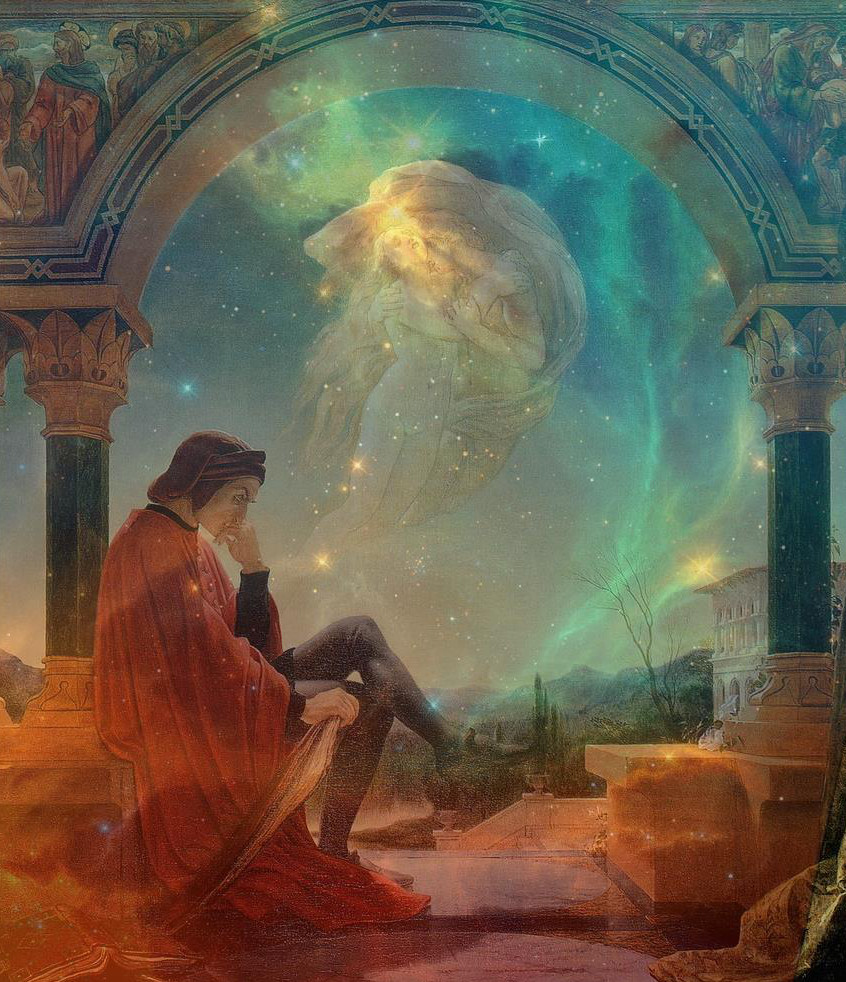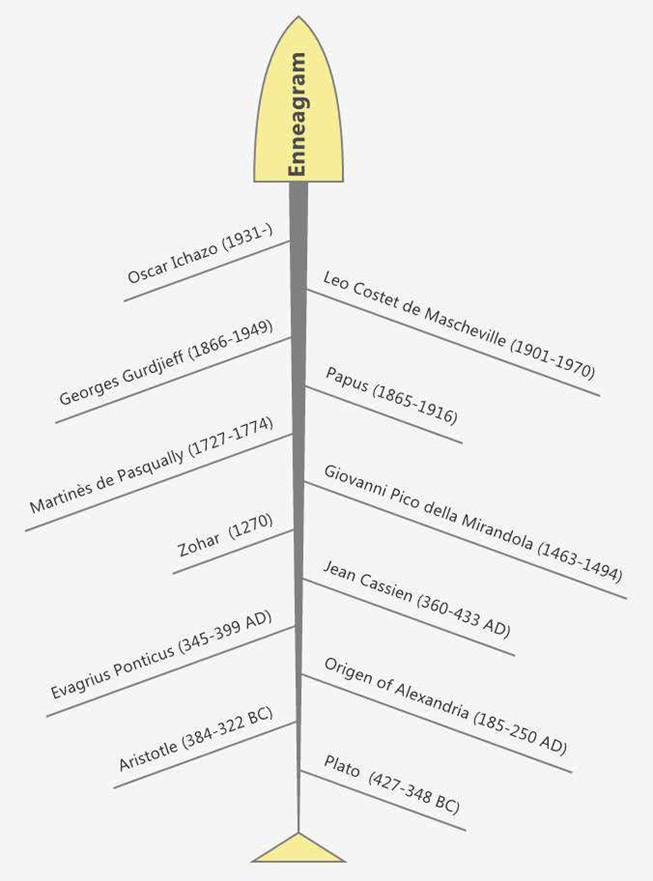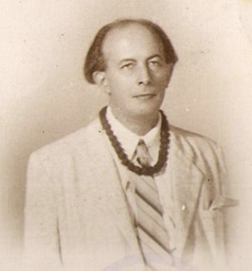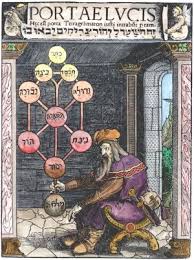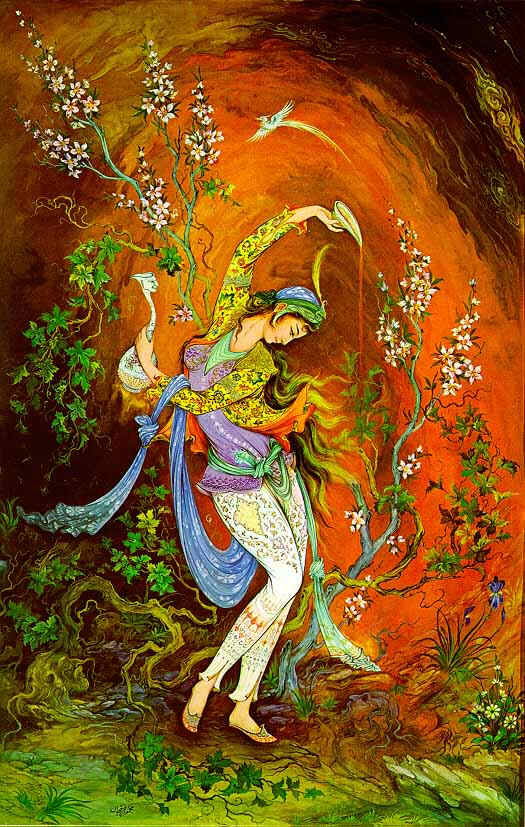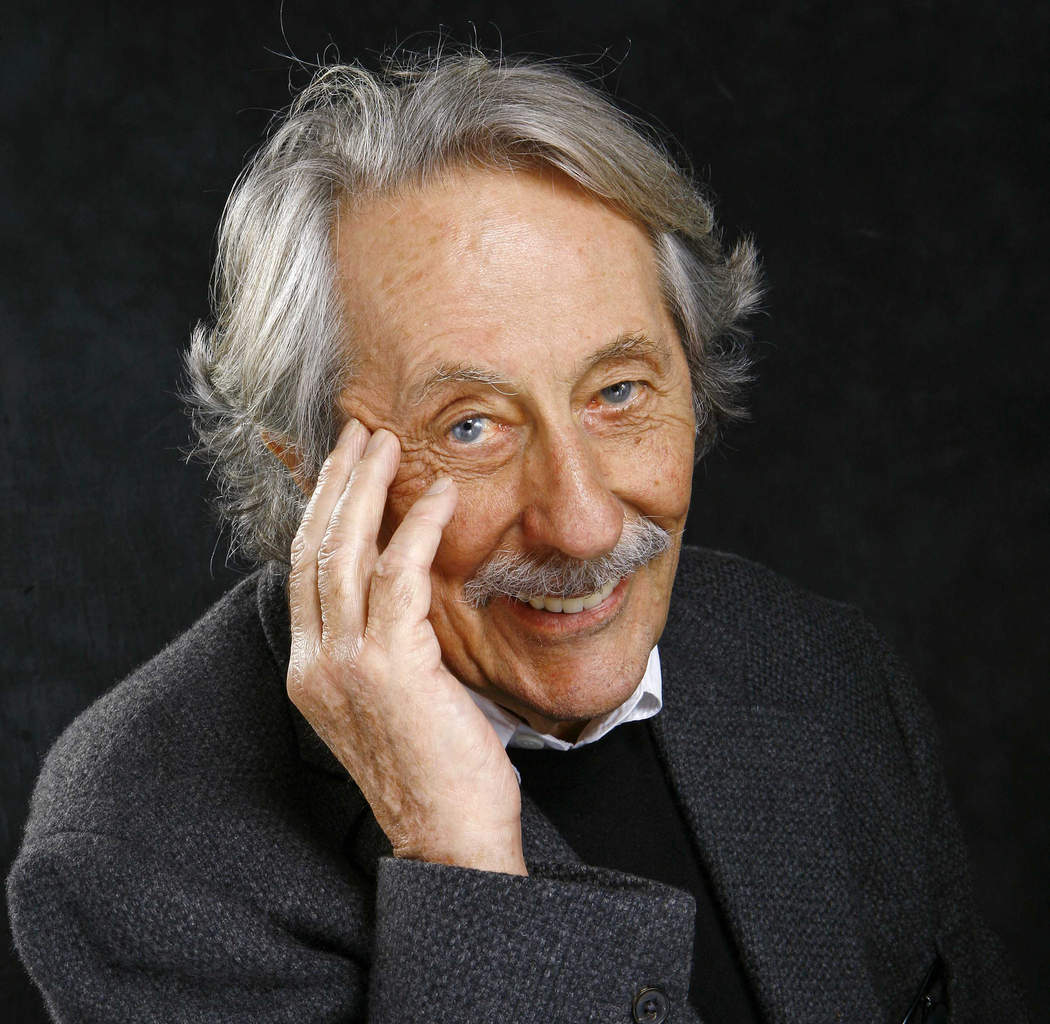Enneagram
missing pictures and illustration sorry, some bugs
Mahmoud Farshian, Iranian painter, arrangment
Turning to the Source: Enneagram Revisited
Bernadette Bollero-Schmitt et Frédéric Schmit MD homeopath
We would like to introduce you to a novel reading of the Enneagram. The Enneagram is like a puzzle, and each player must bring their own piece to the puzzle whatever it may be.
If we have only one or a few pieces it will not allow us to see the entire puzzle, and it will remain necessarily incomplete.
One of the more blocking factors to the evolution of science is the adhesion to incomplete theories as if they represented the entire reality. It’s called dogma. In dogma there is also an unconscious tyranny imposed over the followers: “You cannot deviate from the script, because I am the Truth”. So we have an unconscious fear of deviating and of punishment; that is blocking one’s creativity.
In the Taoist cycle of evolution, each time when yang becomes old, the young yin begins to appear, and vice versa. Or yang in its extreme turns into Yin and Yin in its extreme turns into Yang.
We strongly feel that the Enneagram has reached a point of maturity where it necessarily will move towards a new beginning of a yin rebirth. These two phases of the cycle cannot exist one without the other, and mutually complete each other.
So we are pleased to propose to the enneagram community a new paradigm, not only a few new pieces of the puzzle, but also new and open angles of vision.
History of the enneagram
Bernadette and Frederic Schmitt
From Enneagram Monthly, issue 215, March 2015
In the 1950’s, Oscar Ichazo (born in Bolivia in 1931) was invited to participate in a study group of high-ranking European and Oriental mystics in Buenos Aires, Argentina, composed of Martinists, Theosophists, Rosicrucians and Anthroposophists. Ichazo served them coffee, and they taught him Kabbalah, Sufism, Yoga, Zen and techniques from the Gurdjieff work. (see also EM issues 21, 22, and 23)
Quoting Ichazo:
“This was around 1950, and (one) man invited me to Buenos Aires, where I was involved with a group of mystics, many of whom were seventy or eighty years old when I met them. . . . None of them was South American. They were Europeans or from the Middle East” (Extract from “Interviews with Oscar Ichazo, a 1982 Arica Institute publication”).
According to Claudio Naranjo, Ichazo said specifically that he was handed the whole Tradition that is spread in many branches around the world in various cultures. He was given “the whole works” and the mission of translating it into Western terms.
One of the only names Ichazo has ever mentioned publicly as a teacher and source for him, is Leo Costet de Mascheville, a French spiritual teacher. Who was this man, and how could he be implicated in the genesis of the enneagram?
Leo Costet de Mascheville
We begin the story with his Father, Albert Raymond Costet-Conde de Mascheville (1872 -1943) born in Valence, France.
In 1895 at the age of 23 he became a Delegate of the Supreme Council of the Martinist Order founded by Papus (his real name: Dr. Gerard Encausse, a French medical doctor who founded the Martinist Order-L’ordre Martiniste- in 1887).
1901: birth of his son, Leo Costet de Mascheville (1901-1970) in France.
In 1910 he and his family left France and moved to Argentina arriving on February 26, 1910 in Buenos Aires.
In 1920 Albert Costet initiated his son Leo into the Martinist Order.
Léo Costet de Masheville
Albert Costet sends his son Leo to France on a special mission to re-connect with the Traditional Esoteric Orders of Martinism and the Kabalístic Rosy-Cross.
On March 22, 1927 Albert Costet is made Delegate of the Supreme Council of the Martinist Order of Papus, and starts the Order Kabalistica of the Rosy-Cross in the city of Curitiba, (Brazil).
1932: Leo Costet is transferred (probably on advice of his father) to Montevideo (Uruguay) and founds the esoteric study group GIDEE (Groupe d’études ésotériques) based on the Martinist Order of Papus..
In 1936 Albert Costet moves to Sao Paulo, and appoints his son as President of the Martinist-Order.
On December 23, 1939, the Constitution of the Martinist Order of South America is proclaimed in Porte Alegre, Brazil uniting all Martinists of Brazil, Argentina, and Uruguay.
1941: Leo Costet de Mascheville becomes “Sri Sevananda swami” and his Indian guru Subrahmanyananda makes him his the successor in the lineage of Suddha Dharma.
1949: Leo Costet founded “l’association mystique occidentale-Western Mystical Association” in Montevideo (Urugay) which soon became a center for convergence of different spiritual streams such as Suddha Dharma, Osiris Egyptian Ritual, Ramakrishna Ashram from Kriya Yoga, Sufi, Martinist Order, Maîtreya Mahasangah, Rose-Croix Order, Bodhi Dharma Zen,…
1953: he went to Resende, Rio de Janeiro (Brazil), where he acquired a very large area to establish an Ashram that became famous in Brazil and all over the world.
Everything is in concordance indicating that it was this group of mystics in Buenos Aires in which Ichazo was included, this group created by Albert and then led by Leo Costet de Mascheville \.
Given that the Maschevilles were the representatives of the Martinist Order in South America, it’s interesting to trace back the sources of this teachings to its beginning with Papus.
Papus and the Martinist Order
Papus (1865-1916) founded the Martinist Order in 1887. He was deeply immersed with the European occultist spring and publicly claimed to be the depository of the teaching of the “initiate” Louis-Claude de Saint Martin (1743-1803) who in turn gave credit for his teachings to Martinès de Pasqually (1727-1774). The name “Martinist” came from the name of “Saint Martin” but de Pasqually was the real inspirer of the Martinist Order.
To emphasize the importance of the Kabbalah in the Martinist Order, here’s an excerpt from their French website (http://www.martiniste.org): “Kabbalah is the book of the occult tradition of Israel. It should be in the hands of every man who wishes to deepen the mystery of life, who wonders what the origin and destiny of the existence is, and would like to explore the realm of the invisible to understand relations with the visible world.”
It’s important to know that Kabbalah as taught by the Martinist Order as well as different European esoteric and occultist movements is not the Jewish Kabbalah but a more syncretic form usually called Christian Kabbalah.
Jewish Kabbalah
In 1174, the publication of a strange and enigmatic text in Southern France known as the Bahir was by most commentators, ancient and modern, regarded as the true beginning of Kabbalah. Attempts to establish its authorship or provenance have been largely unsuccessful. The main focus for Kabbalah then moved to Northern Spain, where its salient conceptions attained a stable form, culminating in the publication of the most important and influential of Kabbalistic texts, the Zohar. Moses de León (c. 1250 – 1305) the Spanish rabbi and Kabbalist is thought to have been its author or redactor. The Zohar is a group of books including commentary on the mystical aspects of the Torah (the five books of Moses) and scriptural interpretations as well as material on mysticism, mythical cosmogony and mystical psychology.
Christian Kabbalah
Mixage of Laetitia Casta and Fontaine Medicis, Paris
I wanted to speak briefly today about the Lotus / Padma Wisdom Family one of the five Wisdom Families found in Tibetan Buddhism, corresponding to the five main emotions namely :
Diamant / Vajra family : Anger,
Lotus / Padma : Desire,
Activity / Karma : Jealousy,
Jewels / Ratna : Pride
Awakening / Buddha : Ignorance
We have stated in previous articles the different correlations existing between these 5 families and the typological systems of Jung, Le Senne and Reich, among and of course with the subytpes of the Enneagram. So I would like the reader to refer in particular to the article: “Subtypes, a new and integrative vision “, (not translated into French yet)
Desire and Passion
In tantric Buddhism, this energy is called Padma. “Padma, literally means “lotus flower.” The symbol of the enlightened Padma family is the lotus, which grows and blooms in the mud, yet still comes out pure and clean, virginal and clear. Padma neurosis is connected with passion, a grasping quality and a desire to possess. We are completely wrapped up in desire and want only to seduce the world, without concern for real communication. A person with Padma neurosis speaks gently, fantastically gently, and he or she is seemingly very sexy, kind, magnificent, and completely accommodating. When padma neurosis is transmuted, it become fantastically precise and aware; it turns into tremendous interest and inquisitiveness. Everything is seen in its own distinct way with its own particular qualities and characteristics. Thus the wisdom of padma is called discriminating-awareness wisdom” (Chögyam Trungpa, Journey without a goal).
Padma/Lotus based characters presents themselves as charming persons, be they men or women. They are seductive, soft, very sensitive, prone to emotion, highly sympathetic, sentimental, romantic, sometimes a little bit sugary or pedantic. Often they physical traits are very fine and delicate. There are much softness, grace and beauty in this type.
On the Jungian function it’s feeling. Feeling is how we like or dislike a sensation, based on its agreeable or unpleasant quality. If it’s agreeable, our feeling will like, and on the contrary, will dislike.
Positive aspects:
Compassion, love, affection, kindness, intuition, openness of heart, contact, harmony, empathy, kindness, affability, sweetness, charm, delicacy, refined taste, finesse, love of art and beauty, artistry, loving state, romance, seduction, magnetism, charisma, attractiveness, sensitivity, sensuality, pleasure, intimacy, purity, pristinity.
Negative aspects:
Desire and obsessive attachment. burning, all-consuming and destructive Passion. Desire to please. Great need for love. Need for intimacy, fusion, attention. Excessive dependence. He lives in the eyes of the other. Intense heartache. Feels lack cruelly. Feelings of abandonment, separation, isolation, loss, desolation. Depression. Melancholy. Emotional instability and credulity. Frivolity. Lust. Erotomania. Perversion. Manipulation. Hysteria.
Enneagram :
This family corresponds according to us to the fourth subtype of the Enneagram, that we called Sexual Venus, in opposition to the Sexual Mars, more masculine
Warning ! : This Padma / Lotus Family is, according to our observations, always confused with type 4, or possibly 2 or 6 of the Enneagram … Caution !
We can find in every type this beautiful energy, even in a type 8 or 1 or 9 etc….( Ex : Angelina Jolie, type 5, Emmanuelle Béart, type 1, Sharon Stone type 8, etc )
Excerpts , Book in progress …
Thank you for your angel’s patience …
Illustration Mahmoud Farshian
Rumi
This very deep Rumi poem speaks metaphorically of the interrelated causes of the phenomena ( the dependant origination called Nidanas in sanskrit ) that intrude upon each other in such a compact manner that we find it difficult to discern the parts that make up what we call our Ego.
To be able to dissect each of these constituent parts, to observe how we grasp each of them, always without being aware of it , and how we deceive ourselves of the reality of these phenomena by identifying the part at all, is what we try to do when we meditate.
Let Dhiravamsa speak about the practice of Insight Meditation :
VIPASSANA : THE UNIQUE WAY TO AWAKENING
The Meaning and Scope of Vipassana :
” The literal meaning of Vipassana is total, clear seeing, a profound and panoramic vision. This refers to seeing with the eye of wholeness, which means recognizing that nothing occurs in isolation or independently, that problems need to be seen within the context of whole systems. Seeing in this way, we are able to perceive the intrinsic web of interconnectedness underlying our experience and merge with it. For example, we acknowledge the ways in which we are extraordinary arid miraculous, and at the same time do not hose sight of the ways in which we are simultaneously nothing special, just part of a larger unfolding, as waves on the sea. We can call the rising up and falling back in such brief moment’s “ life spans.” Together with this way of seeing is total freedom from what Albert Einstein called “optical delusion of consciousness,” or “moha” according to the Buddha. Furthermore, seeing in the Vipassana way frees us from the incessant distortions characteristic of our everyday emotional and thought processes, distortions that, as we have seen, can continually undermine the experiencing of our intrinsic wholeness. ”
Insight Medition and Enneagram :
” With regard to the Buddha’s teaching on “How suffering arises and where it ends” or “Paticcasamyppada – Dependent Origination,” I find it very important for all of us to know and to put it into practice. The reason being that the most essential work on the enneagram lies in a complete and precise comprehension of all the ennea-types or characters, their interrelationships, their ruling passions, and how to put an end to their compulsive patterns of conditioning, or how to liberate ourselves from these passions and to break down the character structures of the ennea-types. To put it in the Buddha’s terminology, the enneagram itself is suffering or sankkhâra-dukkha in Pali, the ennea-types’ ruling passions are the root causes of suffering which need to be utterly eliminated or transformed, and total freedom from the ennea-types is equal to Nirvana in life (the utter ending of suffering and the blowing out once and for alt of all the fires that burn our lives,) and the means whereby such a goal can be achieved, is Insight Meditation. This basic meditation comprises the five indispensable factors of the Buddha’s middle path: They are right understanding, right thinking, right mindfulness, right perseverance, and right samadhi (inner stability and peace of mind.) By understanding and practicing the paticcasamuppada in daily life you will be able to speed up as well as to complete your work on the enneagram, which will bear great fruit in your life. ”
I would like to end this conclusion by referring to the Buddha’s wise words in the Dhammapada, which are jewels for everyone :
“Those who are aware and awake always rise.
To no abode are they attached; (not dwelling on any States of mind)
Like the swans that quit their ponds,
Water after water they abandon (and go on.)”
Vigilant and fully aware among the inattentive,
Totally awake among those failing asleep,
The wise person proceeds rapidly
As a fast horse leaving behind a weak nag.”
“Knowing that self-love is first and foremost
One should hold a high esteem for one’s self. During any of the three phases of life
The wise should keep lively vigil.”
Excerpt of the book of Dhiravamsa : Enneagram and Vipassana Meditation
Dhiravamsa, Vipassana master, living in Grand Canaria
Friedrich Nietzsche (1844-1900 )
Type 5, wing 6
“An old solitary tree without leaves, lying in a lush orchard”
Degree of Decay or Neglect
Serious nature, promised to a rich and happy life, which will ultimately compromise his work by errors of judgment, risking criticism, disavowal or rejection. Regrets, disappointments and final solitude. Gabriel in “The Golden Sphere”, the 18th degree of the Lion, which corresponds to the type 5 Yin Fire to which F Nietzsche belongs.
Hahahel, the Angel of Spiritual Wealth:
On the occasion of the birthday of Friedrich Nietzsche, born on October 15, 1844, I wanted to make this short note, without wanting to develop any more, for want of time and certainly also of knowledge necessary for drawing up a portrait of such a character
However, the enormous richness of his personality demands that several articles be devoted to it, covering each of its many facets in the image of its lush and prodigious thought, a source of inspiration for many, contempt or fear for others, others, but which can not leave anyone indifferent.
Here today his two Angels, first his Birth Angel, Hahahel and second his Ennea-Angel , Aladiah
Here a definition, according to Charles Raphael Payeur, of the Angel Hahahel , which brings, first light on what this extraordinary thinker :
(sorry approximative translation )
Hahahel (genius n ° 41):
Radiating with intuition
According to the teaching of the Kabbalah, Hahahel belongs to the choir of the Powers. Now this heavenly hierarchy is associated with the sixth sephirah of the tree of life, Tiphereth, which is incarnated in the visible world in the form of the Sun. Thus, in the same way as the other Powers, the plan of life that Hahahel proposes consists fundamentally in recognizing in himself his true values and then radiating them fully.
As an individual, Hahahel also works with the forces of the second sephirah of the tree of life, Hochmah, which incarnates in the visible world in the form of Uranus. Thus, we can conclude that the plan of life proposed by Hahahel is more precisely to recognize in oneself its true values and to radiate them by relying on its intuition. In this sense, the individual is led to develop high and original (often avant-garde) views that lead him to explore new horizons (interest in new forms of spirituality in particular) or to put his own values at the service of humanity in a pure and disinterested drive (altruism).
The result is generally a spirit of independence and a sense of originality in relations with authority.
Trap: Radiate Inconsistently
The plan of life that Hahahel proposes can however be badly lived. He then leads the individual to become sensitive to spiritual values without his ego, still too much imbued with himself, able to integrate them harmoniously. This sometimes results in serious mystical delusions, and in particular a tendency to believe that he is elected to save humanity or at least to think of himself as an accomplished preacher of “universal love” (strong paranoiac tendencies). There is also a tendency to sink into a delirium of persecution.
Hahahel according to Kabaleb, author of many books on the Kabbalah and the 72 Angels:
The person born under this influence will be distinguished by his greatness of soul and his energy; she/he will devote herself/himself entirely to the service of God, and will not be afraid to suffer in martyrdom. (…) Greatness of soul leads to the last places of organized society backwards of what it should be. Let us not seek the great souls in the first lodges; do not look for them either in the press, in television, in the salons where awards are given, or in the Nobel Prize or other prizes, for they are not there …
The great Souls perform their functions in the invisible and they have enormous capital of energy to carry out their mission.
To dedicate oneself to the service of God, is to dedicate oneself to the eternal personality that each one carries within oneself (…)
The martyrdom for Christ consists in enduring mockery, contempt for society, its persecution, its hatred (…)
The contrary genius influences the apostates, the renegades and all those who dishonor the priesthood by their scandalous conduct, says the Program “
Thus Hahahel becomes the Angel, in his dark side, of the Apostasy, the wicked and the calumniators
Enneagram
We can to this Angel of birth affix that of his Angel in the Enneagram which is, according to us, the Angel Aladiah, which corresponds to the type 5 Sexuel mars Yin:
According to CR Payeur:
Aladiah (Genius No. 10):
Awake to mind with rigor
According to the teaching of the Kabbalah, Aladiah belongs to the choir of the Cherubim. This heavenly hierarchy is associated with the second sephirah of the tree of life, Hochmah, which is incarnated in the visible world in the form of Uranus.
Thus, in the same way as the other cherubim, the plan of life that Aladiah proposes consists basically in awakening to the values of the spirit and to manifest them fully around him.
As an individual, Aladiah also works with the forces of the third sephirah of the tree of life, Binah, which incarnates in the visible world in the form of Saturn. Thus we can conclude that the plan of life proposed by Aladiah consists more precisely in awakening to the values of the spirit and to manifest them fully by asceticism. The individual is thus invited to renounce the chimeras, artifices or illusions of the world in order to better transcend his state of ordinary consciousness and thus open himself to other dimensions of his being. It generally results in a taste of loneliness important though, that the native is not so asocial.
Trap: Stifle the mind by inhibiting rigor
The life plan that Aladiah proposes can however be badly lived. He then leads the individual to seek hard and austere asceticism in everything, the latter being in fact led to believe that mortification and suffering are the only possible paths of transcendence. This usually results in a morbid tendency to manic-depressive self-persecution.
According to Kabaleb, Aladiah is the Angel of Divine Grace.
Here is what he says: “Divine Grace goes further, beyond Mercy, because it forgives and innocent without the need for repentance or change of attitude.” Aladiah is good for those who have hidden crimes and are afraid of being discovered. If we are rich in Graces, we will first forgive our own faults and we will be able to forgive the faults of others. Grace demands nothing in exchange, it modifies in some way the line of conduct of the pardoned, for a state of healing comes into force and the disorders disappear. “
Other articles will follow on F Nietzsche …
You can read more about our new vision of Enneagram on our FB group : “Enneagram and Beyond… ” :
/https://www.facebook.com/groups/618113078366315/
See more about the Ennea- Angels : /http://blog.enneagramme-marie.fr/en/blog/2017/10/08/the-72-angels-and-the-enneagram/
Risks of confusions in the diagnosis of types :
The system of enneagram abounds in traps and confusions in all kinds.
The more we study this in-depth system, the more we discover that what we believe to know and which we identify as being such or such type is being a data of the system that we are unaware of and who comes to supplement and specify the knowledge which we have of ourself and others.
The discovery of these new data come to look further into and highly complex the system, and instead of diverting the student, it must enable him to be able to sail more easily on board of this sumptuous ship that is Enneagram.This one will enable him to arrive to good port, in spite of the storms and violent winds that are resistances of our ego and the movements of our ignorance.To hold firmly the helm and to avoid the wanderings, here is the hard challenge which this formidable tool of transformation and knowledge proposes to each one of us.
Here is for the navigators who we are a small list of the traps and useful errors in order not to lose the North.
Risks of confusion which we can particularly meet between a type and a subtype, such as for example between:
– Sexual Water Yin subtype (or sentimental) with a type 4 , ex : Emmanuelle Béart
– Sexual Water Yang subtype (or (Passionate ) with types 2, 3 and 4 (emotional types) : ex : Sharon Stone
– Sexual Fire Yang subtype (Coleric) with a type 8, or 1, ex : Tony Blair
– Selfpreservation/Earth Yang subtype ( Sanguin/epicurean) with a type 7 or 9, ex: Coluche
– Air Yin subtype ( Apathetic) with a type 5 or 4 , ex : Virginia Wolf
– Air Yang subtype (phlegmatic) with Mental types : 5,6,7, ex :Claire Chazal
– a Space subtype (Bouddha family) with a type 9 , ex : Einstein
– a type 1 Introvert (Fire Yin ) with a type 4 or an emotional type, ex : Lady Diana
– a type 7 Introvert (Wood Yin ) Yin with a type 5 or 6, ex : Woody Allen
This list concerns the most frequent risks of confusion, but there are many others, and that is to take a cofixation for a type, for example a type 1 cofixation 6 for a 6 especially if the person has a subtype Air / Social, which “mentalizes” the subject, etc …
It is easy to see that these confusions on the list relate essentially to the different aspects of subtypes.
As you know, from three, the subtypes have moved to 4 with the extension of the sexual subtype in two (the masculine / Mars and the feminine / Venus), each of these four subtypes being declined in Yang mode (extrovert) and Yin (introverted) bringing these subtypes to the number of eight.
These eight subtypes have been linked to the 8 characters of Gaston Berger / Le Senne), the Wisdom Buddhist Families , and the characters of W Reich
There is two complete articles on the whole model of the eight sub-types in the Enneagram, unfortunately it exists only in English, published in the magazine américian: “Enneagram Monthly”, issue 211 and 224
Hermes / Mercury God of messengers and thieves
Auvergne, Winter 2006
sorry for approximative translation
Hermes / Mercury, God of commerce and thieves finds its place in the 8th sphere of Kabbalah, named Hod, symbolizing Pure Intelligence and the power of conceptualization.
This 8th sephirah corresponds to the type 7 of the Enneagram,
Here a few key words : intelligence, abstraction, conceptualization, rationalization, order, polemic, illusion, distortion, trickery, lying, deceit, dishonesty, mental image, magic, velocity, vivacity, vision of splendor, eternity, youth and of course the most important, the hermaphrodite (masculine-feminine). We also find restriction, inhibition, rigidity.
In its luminous aspect, Hod corresponds to the power of conceptualization, of intelligibility of man, to his power of discernment and knowledge (the caduceus) enabling him to communicate with the most subtle plans of the Divine.
In its obscure side, it refers to a notion of excessive logic, doubt and rationalization, wandering, blindness, illusion, lying, cunning, distortion and travesty of reality. Man remains hermetically closed to the divine spheres and to the essence of things (C. R. Payeur).
How does this fact that these wonderful keywords appear in any textbooks and courses of Enneagram refering to Kabbalah ?
By what incredible magic trick, the key words, lying, deceit, dishonesty, masculine / feminine, are found in type 3?
And what about the gluttony ranked in type 7 ?
Or is it still this thief of Mercury who stole the crown from his rival father, the good, powerful and magnanimous King / Jupiter, attributed to Hesed, the 4th sephirah, and corresponding to the type 3 of the enneagram and of which a few key words, according to CR Payeur: Grace, righteousness, obedience, conformism, idolatry, superficiality, hypocrisy, excess zeal, enthusiasm, productivity, abundance, fructification, insecurity, greed, gluttony, waste.
By what skillful subterfuge the 7 is described in the Enneagram as a rude gluttonous, and planner, well in his life and in his sneakers. ?
Why Ichazo’s description of the schizotypal , how precious, concerning the 7, according to the DSM 4, is obliterated from the textbooks: phobia and social embarrassment, shyness and complexity, cognitive and perceptual distortions, magical thinking, attraction for the paranormal , etc. (the 7 Yin type according to us).
How many people type 7 I have met , very often men, who are classified in type 3, or 5 or 6 by default, of these multiple knowledge and subtleties peculiar to the enneagram.
What about those many keywords distributed pell-mells around the enneagram, like an unbelievable deck of cards?
Will the Enneagram one day give birth to all its secrets?
Type 3 is identified to his persona. He lost contact with his true Self. The persona is a part of the collective unconscious that is appropriated so as to be socially acceptable. One conforms to an image, to a model in an exaggerated way, one passes his personal worries after the collective needs. The good King / Hesed put himself at the service of his people. He is upright and has only one word and does not like to disappoint. He identifies himself with the task to be accomplished which in general is Olympian.
Hod / type 7 symbolizes the power of conceptualization and mentalization (Mercury). He has multiple projects that he has difficulty to follow, he disperses and struggles to follow his commitments. His vision is fragmentary and linear. (Left brain / mental-analytic)
Hesed / type 3 symbolizes the power of synthesis and anabolism (Jupiter). He slaughters a ton of work by excessive conformity, anticipation and excess zeal. His vision is panoramic, global and synthetic. (Right brain / mental-synthetic )
” A peaceful valley, a lake where two swans can fly together. In the background rises a high mountain “
Degree of Peace and Friendship
Sympathetic nature, love for peace and harmony, promised to a happy destiny by talent, relationships, and protections. Beneficial and rewarding associations, artistic gifts.
Sorry for very approximative translation
This article today, at the announcement of the death of the French actor Jean Rochefort, whom I had the pleasure of meeting sometimes on the island of Porquerolles, where he used to stay often. It was short moments but sufficiently striking that leave me the feeling of a being, of course, apparently agreeable, simple and jovial, but what marked me most was the elegance and unspeakable charm of his eyes that flirted with a form of profound sadness, made up of restraint and modesty, but above all, which seemed to invite the other to communicate directly, without any detour, in the arduous world of feelings, the one who never lies, and does not escape, for he is that of the true language of the heart.
So I can not pretend to a portrait of this actor because I did not really know him, just content myself with a few impressions, all subjective though I would like with you, to relate to what we know about our model of the Enneagram and what I believe to be his configuration.
Essay of comparaison between an enneagram and an astrological configuration.
This is a short essay because we are only at the beginning of our research on the links between Enneagram and astrology and certainly not the only one to do it .
The 72 Names of God or Angels in the zodiac
The 72 “Angels” require a little explanation.
Their origin goes back to the Hebrew tradition, and comes from the Psalm of the bible which speaks of the exodus and from which are drawn the 72 names of God.
This Psalm has three sentences of 72 letters each. By taking the first three letters of each of the three sentences you get a first name and so forth to give 72 names which each have 3 letters. The Hebrew tradition arranges the 72 names on the circle of the Zodiac from the 0 ° of Aries and thus each name corresponds to 5°. Thus, each sign of the Zodiac (30 °) contains 6 names (6 X 12 = 72).
This was the support of various spiritual practices in this tradition. During the Italian renaissance, some synergy occurs between the Jewish and Christian traditions, and the 72 names of God became 72 angels.
So please understand these Angels not as external beings, but as divine energies symbolized on the Zodiac and that we carry inside us.
The Rosace of the 72 Angels around the zodiac
There are 4 other levels of distribution of these Angels linked to the 4 Elements in this order Earth Water Fire Air.
If we put one Angel for 5 ° we get the Angel of Earth or the angel that governs the physical plane. If we put an Angel by degree (72 angels will occupy therefore 72 degrees and there will be 5 rounds of 72 angel on the year) it will gives us approximately an Angel by day, and this corresponds to the Angel of the water or the emotional Angel.
If one put the 72 Angels on a week (7.2 degree exactly, there will be 50 cycles of 72 angels) we get the Angel of fire or Angel of intuition. If we put the 72 angels on a day we get the Angel of Air or Angel of the mental. And finally, (but there we’ll talk another day) the 5 ° Angel is the Angel of Space or Angel of our deepest identity.
His knowledge is obtained through analogy with the Enneagram.
The 72 Angels or Archetypes in the Enneagram :
The link we did between these 72 energies and the Enneagram is possible because in our model we identified 8 subtypes (4 yin and yang 4 = 8) combining with the 9 types (8 X 9 = 72). The fourth subtype being as you know it now, the famous Sxvenus subtype, opposed to the Sxmars subytpe (See article in Enneagram Monthly , issue 211 and 224 )
The link made between the 72 angels and 72 archetypes of the Enneagram has not been it following our inspiration or understanding but by a quite elaborate mathematical calculation and that we eventually checked in practice by observation.
I say this because when we say that such an Angel is linked to such type of the Enneagram is not by a psychological reflection that we got there but by a logic mathematical calculation, which is much deeper.
Thus these 72 Angels or Archetypes of the Enneagram do not rank in the order of the zodiac (the first Angel in type 1, etc.), but according to a very precise order related to the four elements and their correspondences with the eight subtypes of each 9 Types
We have Angels of Fire, two by type, so 18 Angels of Fire, then 18 Angels of Water, then Air, then Earth, which makes 72 Angels in total that cover the whole Model of the “ Enneagram as we have elaborated it.
As example, for type 1 :
Fire Yang 1(sexua l Mars) : Angel Vehuel n° 1
Fire Yin 1 (sexual Mars ): Angel Jeliel n°2
Air Yang 1 (social ) : Angel Aniel n° 37
Air Yin 1 (social ) : Angel Haamiah n°38
For copyright reasons, we cannot publish here the totality of the Angels classification in the Enneagram. Thanks for understanding
To be followed, if you like it …
See more on our FB group : “Enneagram and Beyond… ” https://www.facebook.com/groups/618113078366315/?ref=bookmarks
Alain Delon in the movie “The Leopard ” by Luchino Visconti
The air aspect of Fire (under sexual-Mars / Social)
Sorry for the approximative translation
The Subtypes of the Enneagram and the Minor Tarot cards :
I have long wanted to tell you about the link we have made between the types of the Enneagram, their subtypes, and the Tarot cards.
I know that for many it all seems mysterious, having not yet published anything on the subject, and in particular on our methodology of research which explains each one of our classifications.
In appearance these new classifications seem to complicate the model, but in reality it sheds unexpected light on the types of the Enneagram, but also and especially, on the famous subtypes, the badly named ones of the rest. ..
Thus we see that each subtype, independently of its associated type, has a definition of its own.
I will not enter here in more details, just maybe remember that a subtype is never, “pure”, but always associated with a second one that is minor
For example we can be a Social and Sexual Mars at the same time, or Autopreservation and Social, etc …
As you know, for those who already follow our work, each subtype corresponds to an element of Tradition and, as we see it today, to one of the four figures of the Tarot:
Sexual Mars = Fire (Wands)
Sexual Venus = Water (Cups)
Social = Air (Swords)
Autopreservation = Earth (Pentacles)
Each figure is married to each other, so we can have the Cavalier de Coupes (the fire aspect of Water, or the Sexual/Venus subtype combined with sexual Mars ), the Queen of Swords (the water aspect of the Air, or the Social / Sexual venus sub-type), the Queen of Disks (the water aspect of the Earth, or Self-preservation / sexual venus subtype), etc, etc …
Working on illustrating one of these combinations, namely the air aspect of the Fire, or in other words the Sexual Mars associated with the social sub-type in which I put Alain Delon amongst others, I come across the definition of the Prince of Aleister Crowley’s book “The Book of Toth,” which is to be mistaken only that of Trancède, the beautiful nephew of the Prince of Salina, in Luchino Visconti’s movie “The Leopard ” beauty is matched only by his intrepid and impetuous youth and rebellion. If we look at interviews on Alain Delon, this definition suits him like a glove, which seems to stick to his skin … and to his character of Trancède, many years later ! …
The Prince of Wands :
The prince of Wands tends sometimes to act on an impulse. To undergo external influences, sometimes indecisive, and particularly for things without importance,. He is often violent, especially when he expresses an opinion, but this one to which he seems so formal does not necessarily entail him. He affirms with force only for the pleasure of asserting. In fact he will be very slow to make a decision, but he will always consider a question in its two aspects. Fundamentally just, he instinctively leaps that justice can not be achieved in the intellectual sphere. Excessively noble and generous of character, he can be an extravagant boastful and laughing discreetly about his boasting and his author. Fiercely romantic in particular to all that relates to history and tradition, he will make a sensational blow or make savvy jokes. He can choose a harmless person and cover him with all the jokes possible for years as Swift tormented the unfortunate Partrigde; all this without the least animosity and being ready to give him his shirt if his victim needed it. His sense of humor spares nothing and can make him a mysterious figure. fear for no reason by people who ignore everything except his name – a symbol of Terror. Pride is one of his greatest defects. He exasperates me with all mediocrity and insignificance. His courage is inexhaustible and his resistance indefatigable Always in struggle against superior forces, he always ends by winning. The main cause of all this is the immense ability to work for the job. “Without covetousness” of the result. The haughty contempt with which he considers the world-a contempt coexisting nevertheless with a profound respect marveled for every man and every woman as “star” is perhaps responsible for his attitude …
In its more negative aspect the character degenerates and we can find a great cruelty, partly imprinted with sadism and partly provoked by the insensibility that results from indifference, it can be also intolerant, partial, indolent. Finally he can also be a braggart with a hollow mind or a great coward.
Ennea -configuration of Alain Delon, in our opinion:
Mental center
Type 5
Wing 4
Cofixations: 1 and 3
Sub-types: Sexual Fire and Social

